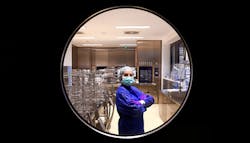Creating optimal SPD takes planning, keen assessment
Many Sterile Processing (SP) professionals are happy to share their visions of a “perfect” department. This often includes the most sophisticated processing equipment; enhanced automation; sufficient instrumentation inventory to prevent requests for rapid turnover; larger work areas that are uncluttered and facilitate proper flow; height-adjustable sinks and tables; top-quality inspection tools such as lighted magnification and borescopes; and an adequate number of well-trained employees for all shifts, among other wish list items.
Although few can argue the merits of sprawling SPDs and the latest and greatest technologies, experts routinely point out that creating an optimal SPD is more about effective layout and workflow and ensuring all technicians are provided the proper essentials for all reprocessing tasks (correct brushes, detergents and inspection tools, ongoing training, and the latest guidelines and instructions for use, etc.).
Lay of the land
Whether an SPD is old, cramped and outdated or a grand and expansive environment filled with all the latest and greatest equipment, ensuring a good flow that keeps proper separation between clean and dirty areas and keeps needed supplies and work areas in easy reach of technicians to prevent inefficiencies and wasted steps is imperative. Uni-directional flow is essential to ensure soiled instruments move progressively to clean work areas, and this point is highlighted repeatedly in standards and guidelines from professional organizations such as the American Society of Heating, Refrigerating and Air-Conditioning Engineers (ASHRAE), the Facility Guidelines Institute (FGI), the American Society for Healthcare Engineering (ASHE), the Association of PeriOperative Registered Nurses, the Association for the Advancement of Medical Instrumentation (AAMI), and the Association for Professionals in Infection Control and Epidemiology (APIC).
ANSI/AAMI ST79 Comprehensive guide to steam sterilization and quality assurance in health care facilities states that the SPD should include separate areas within the decontamination area for receipt and processing of contaminated items that will undergo terminal sterilization after decontamination; receipt and processing of contaminated items for which the decontamination process incorporates decontamination procedures; and receipt and processing of equipment that requires manual disinfection post-cleaning. There should also be a separate clean work room for packaging, sterilization and storage of clean items; walls or partitions between functional work areas to control the spread of contaminants; enough space for all functions and equipment; systems to contain contaminants and minimize staff exposure to bloodborne pathogens and other potentially infectious organisms; and a workflow pattern that allows safe handling of items across every stage of processing.
Citing the 2018 edition of the FGI guidelines, Gail Horvath, MSN, RN, CNOR, CRCST, Patient Safety Analyst and Consultant for ECRI Institute, reminds SP professionals to carefully explore the minimum requirements for their SP spaces. Will a two-room processing area sufficiently be able to meet the facility’s procedural volume and demand or will more rooms be needed? Also, is the facility using countertop sterilizers or large, floor-loading units? It is important to routinely evaluate the facility’s volume, along with the SPD’s capabilities, to ensure customers’ and patients’ needs are being safely and efficiently met. A three-zone workflow is ideal for ensuring flexibility and adaptability of the space and is recommended by the Department of Defense for military health system facilities. This design uses double-door or pass-through steam and low-temperature sterilizers to directly connect the clean room and sterile storage area. Additionally, a triple-zone setup allows instrument inspection, assembly, wrapping and containerization to occur in a dedicated area, with minimal movement.
Track current supplies, equipment, staffing
Once current and future projections are determined, SP leaders must assess whether the SPD is equipped to meet those demands. Prior to purchasing new capital equipment, Biomedical Engineering and Facilities Management staff should verify that the facility has the necessary mechanical, electrical and utility requirements and that the SPD has enough square footage to accommodate the equipment and its required plumbing and ventilation and also allow access for proper cleaning and repairs.
HVAC and utility requirements should also be prioritized, and temperature and humidity levels should be carefully monitored and documented. ASHRAE Standard 170 states that temperature for sterile storage areas should not exceed 75 degrees F, and relative humidity should not exceed 60%. When a variance occurs, a thorough risk assessment should be performed, Horvath explained. If temperature or humidity levels only momentarily drop outside of acceptable ranges, breaking everything down and reprocess it may not be required like it would be if condensation is present or there is other evidence of compromised sterility.
Workstations, tables, chairs and sinks should be properly sized. Comfort and safety can be further improved by ergonomic equipment that can be raised or lowered to accommodate technicians of varying heights. Ensuring proper lighting is also critical, and this involves both overhead and task lighting; bright light is especially helpful when performing detailed instrument inspection, and SP technicians should also have ready access to borescopes to allow illuminated viewing of lumens and other interior components. Of course, staffing and an emphasis on continuing education, certification and professional development are equally vital to successful SPD operations.
“[Employees] should be qualified and competent across all aspects of Sterile Processing, including biohazard transportation, decontamination, preparation, packaging, sterilization, sterile storage, and distribution of sterile medical devices,” Horvath said. “We are always going to promote certification because it validates the expertise and the employee’s commitment to the profession and increases the recognition as a healthcare professional.”
About the Author

Julie E. Williamson
Julie Williamson is the IAHCSMM Communications Director.
